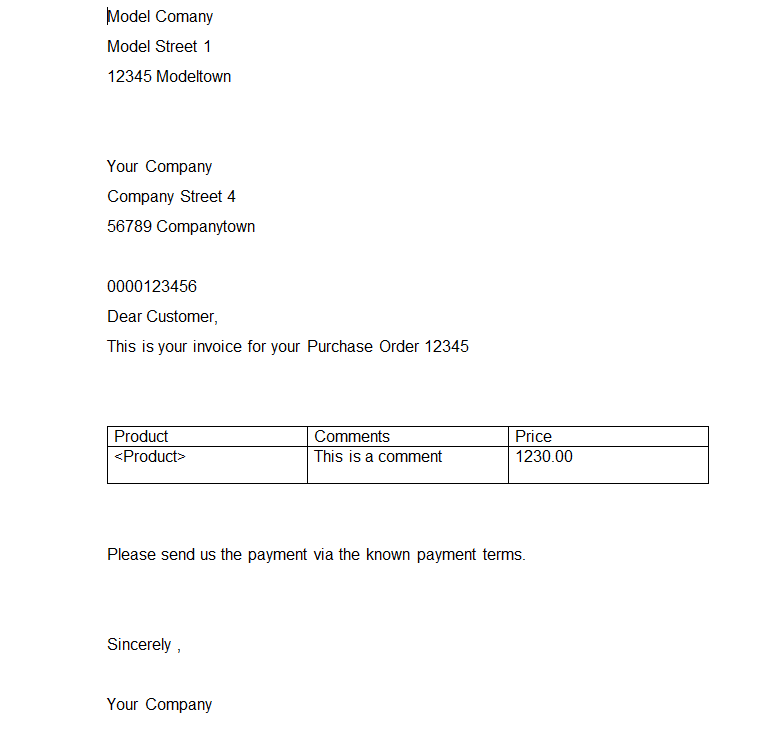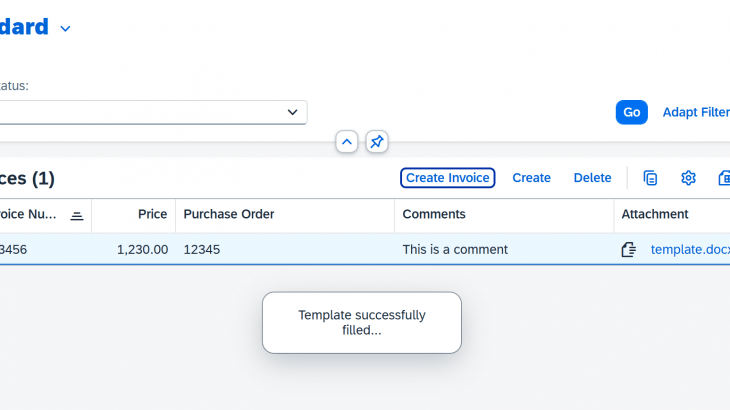Introduction
In this blog post, I would like to share some insights for generating OpenXML documents by use of the RESTful Application Programming Model with Cloud-released development objects. With this app, you will be able to upload .docx templates and fill them with information from you CDS view (could be used for generating invoices, business documents and so on…).
Prerequesites
- SAP BTP ABAP environment or an S/4 system to your disposal.
- Eclipse IDE installed on your local machine with the ABAP Development Tools.
Shortcut with abapGit:
For those who are using abapGit, feel free to check out the code from my GitHub repo!
Step 1:
Create a database table with the following config (hint: do not forget to generate custom domains for mime type and attachment type)
@EndUserText.label : 'Invoice for document generation'
@AbapCatalog.enhancement.category : #EXTENSIBLE_ANY
@AbapCatalog.tableCategory : #TRANSPARENT
@AbapCatalog.deliveryClass : #A
@AbapCatalog.dataMaintenance : #RESTRICTED
define table zmri_invoice {
key client : abap.clnt not null;
key invoice : ebeln not null;
comments : abap.char(30);
attachment : zmriattachment;
mimetype : zmimetype;
filename : zfilename;
purchaseorder : abap.char(30);
price : abap.dec(8,2);
local_created_by : abp_creation_user;
local_created_at : abp_creation_tstmpl;
local_last_changed_by : abp_locinst_lastchange_user;
local_last_changed_at : abp_locinst_lastchange_tstmpl;
last_changed_at : abp_lastchange_tstmpl;
}Step 2:
Generate ABAP repository objects by right-clicking on the previously created database table.
Choose the ABAP RESTful Application Programming Model (OData UI Service) variant.
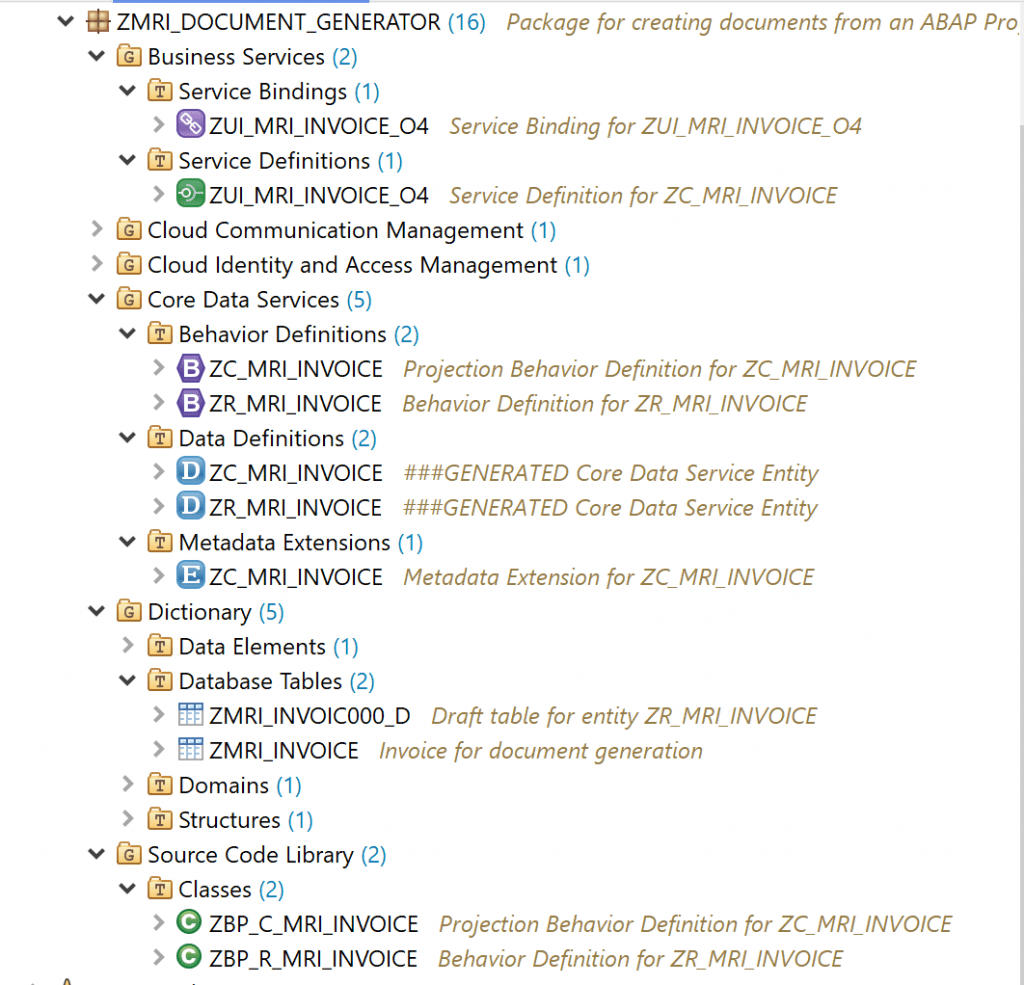
Step 3
Create a custom action in your Behavior Definition:
managed implementation in class ZBP_R_MRI_INVOICE unique;
strict ( 2 );
with draft;
define behavior for ZR_MRI_INVOICE alias ZrMriInvoice
persistent table ZMRI_INVOICE
draft table ZMRI_INVOIC000_D
etag master LocalLastChangedAt
lock master total etag LastChangedAt
authorization master( global )
{
field ( mandatory : create )
Invoice;
field ( readonly )
LocalCreatedBy,
LocalCreatedAt,
LocalLastChangedBy,
LocalLastChangedAt,
LastChangedAt;
field ( readonly : update )
Invoice;
create;
update;
delete;
action ( features : global ) createMSWordInvoice ;
draft action Activate optimized;
draft action Discard;
draft action Edit;
draft action Resume;
draft determine action Prepare;
mapping for ZMRI_INVOICE
{
Invoice = invoice;
Comments = comments;
Attachment = attachment;
Mimetype = mimetype;
Filename = filename;
PurchaseOrder = purchaseOrder;
Price = price;
LocalCreatedBy = local_created_by;
LocalCreatedAt = local_created_at;
LocalLastChangedBy = local_last_changed_by;
LocalLastChangedAt = local_last_changed_at;
LastChangedAt = last_changed_at;
}
}Step 4:
Implement the custom action in your behaviour implementation class:
CLASS lhc_zr_mri_invoice DEFINITION INHERITING FROM cl_abap_behavior_handler.
PRIVATE SECTION.
CLASS-DATA: mt_data TYPE zmri_invoice.
DATA:
lv_content TYPE xstring,
lo_zip TYPE REF TO cl_abap_zip.
METHODS:
get_global_authorizations FOR GLOBAL AUTHORIZATION
IMPORTING
REQUEST requested_authorizations FOR ZrMriInvoice
RESULT result,
get_global_features FOR GLOBAL FEATURES
IMPORTING
REQUEST requested_features FOR ZrMriInvoice
RESULT result,
createMSWordInvoice FOR MODIFY
IMPORTING keys FOR ACTION ZrMriInvoice~createMSWordInvoice.
ENDCLASS.
CLASS lhc_zr_mri_invoice IMPLEMENTATION.
METHOD get_global_authorizations.
* This method does not need an implementation
ENDMETHOD.
METHOD createMSWordInvoice.
* Select document to be filled
SELECT * FROM zc_mri_invoice
FOR ALL ENTRIES IN @keys
WHERE invoice = @keys-invoice
INTO CORRESPONDING FIELDS OF @MT_data.
ENDSELECT.
* Create zip class instance
lo_zip = NEW cl_abap_zip( ).
* Search for main document part
DATA lv_index TYPE string VALUE 'word/document.xml'.
* Load attachment into zip class object
lo_zip->load( zip = mt_data-attachment check_header = abap_false ).
* Fetch the binaries of the XML part in the attachment
lo_zip->get(
EXPORTING
name = lv_index
IMPORTING
content = lv_content
).
* Convert the binaries of the xml into a string
DATA(lv_string) = xco_cp=>xstring( lv_content
)->as_string( xco_cp_character=>code_page->utf_8
)->value.
* Search for the text to be replaced and fill with the information in your data set
REPLACE FIRST OCCURRENCE OF '<InvoiceNumber>' IN lv_string
WITH mt_data-Invoice.
REPLACE FIRST OCCURRENCE OF '<Purchase Order>' IN lv_string
WITH mt_data-PurchaseOrder.
REPLACE FIRST OCCURRENCE OF '<Comments>' IN lv_string
WITH mt_data-Comments.
DATA lv_price TYPE string.
lv_price = mt_data-Price.
REPLACE FIRST OCCURRENCE OF '<Price>' IN lv_string
WITH lv_price.
* Convert the changed XML string into binaries
DATA(lv_new_content) = xco_cp=>string( lv_string )->as_xstring( xco_cp_character=>code_page->utf_8
)->value.
* Delete "old" main document part from the zip file
lo_zip->delete(
EXPORTING
name = lv_index
).
* Add "new" main document part to the zip file
lo_zip->add(
EXPORTING
name = lv_index
content = lv_new_content
).
* Save the new zip file
DATA(lv_new_file) = lo_zip->save( ).
* Upload changed docx file
MODIFY ENTITIES OF zr_mri_invoice IN LOCAL MODE ENTITY ZrMriInvoice
UPDATE SET FIELDS WITH
VALUE #( (
Invoice = mt_data-Invoice
Attachment = lv_new_file
) )
FAILED failed.
APPEND VALUE #( %msg = new_message_with_text( severity = if_abap_behv_message=>severity-success text = 'Template successfully filled...' ) ) TO reported-ZrMriInvoice.
ENDMETHOD.
METHOD get_global_features.
* This method does not need to be implemented
ENDMETHOD.
ENDCLASS.Explanation: In this implementation class, the cl_abap_zip class (which is released for cloud development) is used to load the .docx template. If you didn’t already know, a .docx file is basically a ZIP-file. In order to get the main document part, we need to fetch the “word/document.xml” file within the zip object by applying the lo_zip->get() method. This method returns an XSTRING which has to be converted into an UTF-8 encoded string, for us to modify the content of the main document part. For the binary-to-string conversions the xco_cp class is used, which is part of the XCO library (I can only recommend using this library as it has some great features). Afterwards the converted XML-string has to be modified with the invoice details from your CDS view. The modified XML-string has to be converted back into binaries, by use of the same class. The last step is to delete the “old” main document part from the zip object and add the new document content to the zip object. Now update the attachment field in your CDS entity and that’s it. Your app should now be able to populate a .docx-file with information from your CDS view.
Step 5:
Create a metadata extension and a service binding for your Fiori Frontend and test the application:
@Metadata.layer: #CORE
@UI: { headerInfo: {
typeName: 'Invoice',
typeNamePlural: 'Invoices',
title: { type: #STANDARD, value: 'Invoice' },
description: { type: #STANDARD, value: 'Invoice' } },
presentationVariant: [{
sortOrder: [{ by: 'Invoice', direction: #ASC }],
visualizations: [{type: #AS_LINEITEM}] }] }
annotate view ZC_MRI_INVOICE with
{
.facet: [ {
label: 'General Information',
id: 'GeneralInfo',
type: #COLLECTION,
position: 10
},
{ id: 'Invoicedet',
purpose: #STANDARD,
type: #IDENTIFICATION_REFERENCE,
label: 'Invoice Details',
parentId: 'GeneralInfo',
position: 10 } ]
: { lineItem: [ { position: 10, importance: #HIGH , label: 'Invoice Number'} ] ,
identification: [ { position: 10 , label: 'Invoice Number' } ] }
Invoice;
: { lineItem: [ { position: 20, importance: #HIGH , label: 'Purchase Order'} ] ,
identification: [ { position: 20 , label: 'Purchase Order Number' } ] }
PurchaseOrder;
: { lineItem: [ { position: 20, importance: #HIGH , label: 'Price'} ] ,
identification: [ { position: 20 , label: 'Price' } ] }
Price;
: { lineItem: [ { position: 20, importance: #HIGH , label: 'Comments'} ] ,
identification: [ { position: 20 , label: 'Comments' } ] }
Comments;
:
{ lineItem: [ { position: 30, importance: #HIGH , label: 'Attachment'}, { type: #FOR_ACTION, dataAction: 'createMSWordInvoice' , label: 'Create Invoice' } ],
identification: [ { position: 20 , label: 'Attachment' }]
}
Attachment;
.hidden: true
MimeType;
.hidden: true
Filename;
}Test the application by creating an entry and uploading a docx-template.
The template could look something like this:
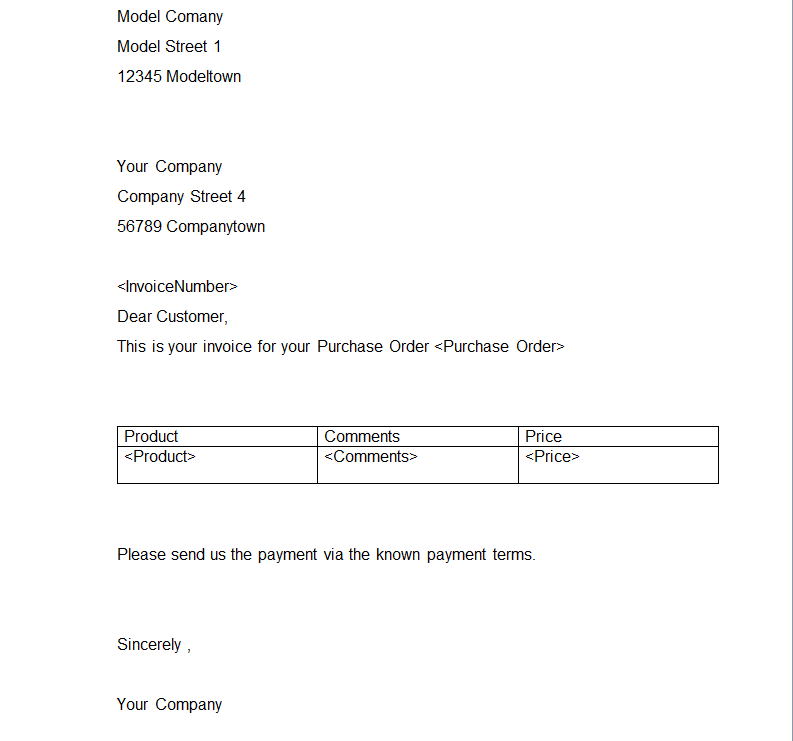
Now select the entry and use the custom action to fill the template with your data:
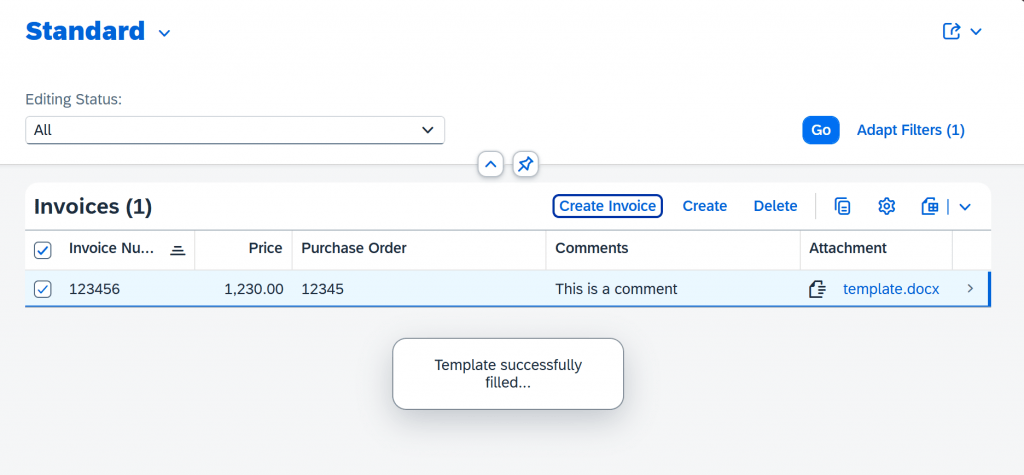
After the success message, click on the attachment (template.docx) and verify that the placeholders have been filled:
